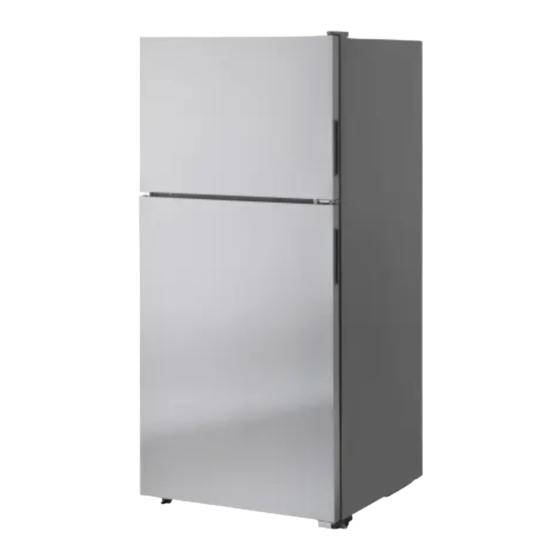IKEA IK8FXNGFDM02 Installation And User Instructions Manual - Page 11
Browse online or download pdf Installation And User Instructions Manual for Refrigerator IKEA IK8FXNGFDM02. IKEA IK8FXNGFDM02 18 pages.

Ice Maker
Turning the Ice Maker On/Off
NOTE: Do not force the wire shut-off arm up or down.
To turn the ice maker on, simply lower the wire shut-off arm.
NOTE: Your ice maker has an automatic shut-off. As ice is
made, the ice cubes will fill the ice storage bin and the ice
cubes will raise the wire shut-off arm to the Off (arm up)
position.
To manually turn the ice maker off, lift the wire shut-off arm to
the Off (arm up) position and listen for the click to make sure
the ice maker will not continue to operate.
NOTE: Turn the ice maker off before removing the ice storage bin
to serve ice or to clean the bin. This will keep the ice cubes from
dropping out of the ice maker and into the freezer compartment.
After replacing the ice storage bin, turn on the ice maker.
Ice Production Rate
NORMAL Ice Production: The ice maker should produce
approximately 8 to 12 batches of ice in a 24-hour period. If ice
is not being made fast enough, turn the Freezer control toward
a higher (colder) number in half number steps. (For example, if
the control is at 3, move it to between 3 and 4.) Wait 24 hours
and, if necessary, gradually turn the Freezer Control to the
highest setting, waiting 24 hours between each increase.
MAXIMUM Ice Production (on some models): The ice maker
should produce approximately 16 to 20 batches of ice in
a 24-hour period. If your refrigerator has the maximum ice
production feature, push the switch to MAX.
Remember
Allow 24 hours to produce the first batch of ice. Allow 3 days
to completely fill the ice storage bin. Discard the first three
batches of ice produced.
The quality of your ice will be only as good as the quality of the
water supplied to your ice maker. Avoid connecting the ice
maker to a softened water supply. Water softener chemicals
(such as salt) can damage parts of the ice maker and lead to
poor quality ice. If a softened water supply cannot be avoided,
make sure the water softener is operating properly and is well
maintained.
Do not store anything on top of the ice maker or in the ice
storage bin.
REFRIGERATOR FEATURES
Your model may have some or all of these features.
Important information to know about glass shelves
and covers:
Do not clean glass shelves or covers with warm water when
they are cold. Shelves and covers may break if exposed to
sudden temperature changes or impact, such as bumping.
Tempered glass is designed to shatter into many small,
pebble-size pieces. This is normal. Glass shelves and covers
are heavy. Use both hands when removing them to avoid
dropping.
Refrigerator Shelves
The shelves in your refrigerator are adjustable to match your
individual storage needs.
Storing similar food items together in your refrigerator and
adjusting the shelves to fit different heights of items will make
finding the exact item you want easier. It will also reduce the
amount of time the refrigerator door is open, and save energy.
To remove and replace a shelf:
1. Remove items from the shelf.
2. Slide the shelf straight out to the stop.
3. Depending on your model, lift back or front of the shelf past
the stop. Slide shelf out the rest of the way.
4. Replace the shelf by sliding the back of the shelf into the track
in the wall of the cabinet.
5. Guide the front of the shelf into the shelf track. Be sure to slide
the shelf in all the way.
Crisper
Crisper Drawers
To remove and replace the crisper drawer:
1. Slide the crisper drawer straight out to the stop. Lift the front
and slide the drawer out the rest of the way.
2. Replace the drawer by sliding the drawer in fully past the stop.
Crisper Cover
To remove and replace the crisper cover:
1. Remove the crisper(s).
2. Pull the glass straight out.
11
